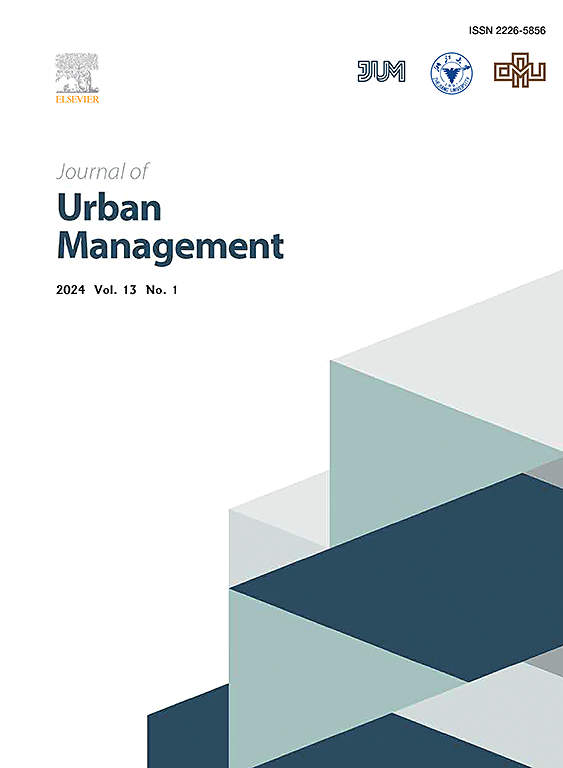城市空间结构如何影响可持续发展目标11.7?中国265个城市的实证研究
IF 5
2区 社会学
Q1 URBAN STUDIES
引用次数: 0
摘要
联合国可持续发展目标11.7 (SDG 11.7)主要用于评估城市公共空间的可持续性。城市空间结构(USS)可以深刻影响可持续发展目标11.7的水平。现有研究通常侧重于单一维度的USS指标对可持续发展目标11.7的影响,往往未能将多个维度纳入综合评估体系。基于对中国265个城市的SDG 11.7的评估,本研究选择了综合反映城市规模、城市蔓延、城市可达性、城市扩张、城市紧凑性和城市形态等城市可持续发展各个方面的六维可持续发展指标。然后,利用面板回归、地理和时间加权回归、分位数回归和空间Durbin模型系统地分析了这些指标对可持续发展目标11.7的影响。此外,本研究还探讨了USS对SDG 11.7影响的空间异质性、非线性特征和空间效应。结果表明:(1)城市规模、可达性和紧凑性显著影响可持续发展目标11.7,城市规模和可达性具有正向影响;(2)可持续发展战略对可持续发展目标11.7的影响在不同的空间位置上存在差异,且这些空间差异随着时间的推移而演变;(3) USS对SDG 11.7的影响呈现非线性特征。在可持续发展目标11.7水平较高的城市,城市可达性和形状的积极影响更为明显;(4) USS不仅影响本地SDG 11.7,还通过空间效应影响周边城市的SDG 11.7。这些发现阐明了城市可持续发展是如何影响可持续发展目标11.7的,从而为可持续城市发展提供决策支持。本文章由计算机程序翻译,如有差异,请以英文原文为准。
How does urban spatial structure affect sustainable development Goal 11.7? An empirical study of 265 cities in China
The United Nations’ Sustainable Development Goal 11.7 (SDG 11.7) is primarily used to assess the sustainability of urban public spaces. Urban spatial structure (USS) can profoundly influence the level of SDG 11.7. Existing research has typically focused on the impact of single-dimensional USS indicators on SDG 11.7, often failing to incorporate multiple dimensions into a comprehensive evaluation system. Based on an assessment of SDG 11.7 in 265 Chinese cities, this study selected six-dimensional USS indicators that comprehensively reflect various aspects of USS, namely, urban size, urban sprawl, urban accessibility, urban expansion, urban compactness, and urban shape. It then systematically analyzed the impact of these indicators on SDG 11.7 using panel regression, geographically and temporally weighted regression, quantile regression, and the spatial Durbin model. Furthermore, this study explored the spatial heterogeneity, nonlinear characteristics, and spatial effects present in the influence of USS on SDG 11.7. The findings indicated the following: (1) urban size, accessibility, and compactness significantly impacted SDG 11.7, with urban size and accessibility having positive effects; (2) the impact of USS on SDG 11.7 varied across different spatial locations, and these spatial disparities evolved over time; (3) the impact of USS on SDG 11.7 exhibited nonlinear characteristics. In cities with higher SDG 11.7 levels, the positive effects of urban accessibility and shape became more pronounced; (4) USS affected not only local SDG 11.7 but also that of neighboring cities through spatial effects. These findings elucidate how USS affects SDG 11.7, thereby providing decision support for sustainable urban development.
求助全文
通过发布文献求助,成功后即可免费获取论文全文。
去求助
来源期刊

Journal of Urban Management
URBAN STUDIES-
CiteScore
9.50
自引率
4.90%
发文量
45
审稿时长
65 days
期刊介绍:
Journal of Urban Management (JUM) is the Official Journal of Zhejiang University and the Chinese Association of Urban Management, an international, peer-reviewed open access journal covering planning, administering, regulating, and governing urban complexity.
JUM has its two-fold aims set to integrate the studies across fields in urban planning and management, as well as to provide a more holistic perspective on problem solving.
1) Explore innovative management skills for taming thorny problems that arise with global urbanization
2) Provide a platform to deal with urban affairs whose solutions must be looked at from an interdisciplinary perspective.
 求助内容:
求助内容: 应助结果提醒方式:
应助结果提醒方式:


